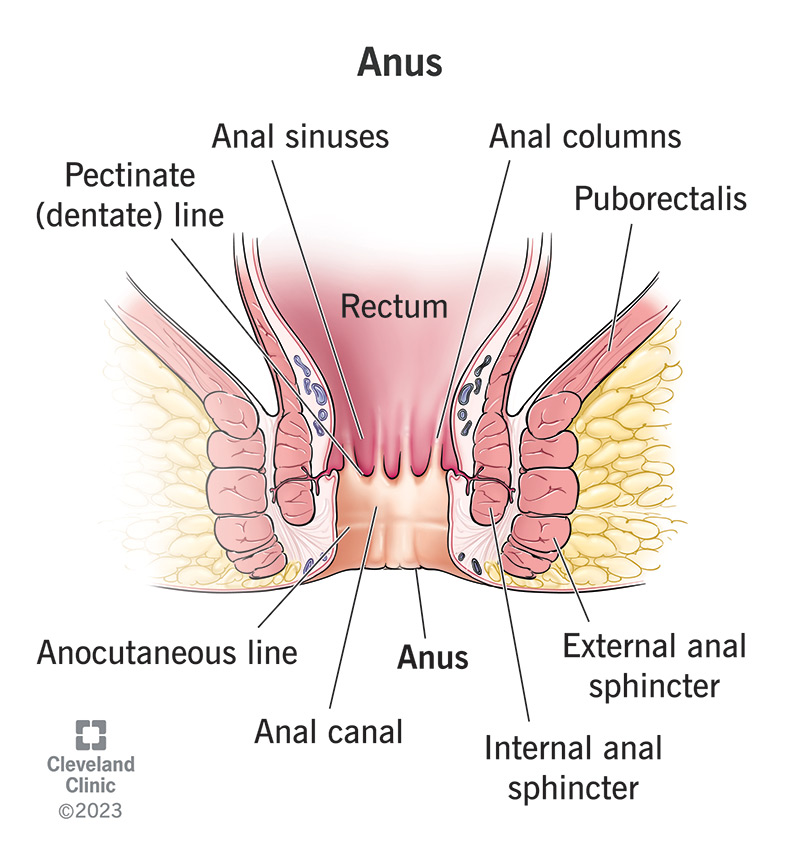Your anus is the end of your large intestine, where food waste completes its journey through your digestive tract and makes its exit. Muscles, nerves and mucous membranes in your anus work together to make healthy bowel movements that you can control. They also work to keep your anus closed to infections coming in from the outside.
Advertisement
Cleveland Clinic is a non-profit academic medical center. Advertising on our site helps support our mission. We do not endorse non-Cleveland Clinic products or services. Policy

Your anus is the end of your large intestine — the last three or four centimeters of it. This is where your large intestine opens to the outside to let your poop come out. At your anus, the tissue lining the inside of your large intestine begins to change from tender mucosa to normal skin. Ring-like muscles called sphincters surround your anus and keep it closed until they’re activated to let your poop come out.
Advertisement
Cleveland Clinic is a non-profit academic medical center. Advertising on our site helps support our mission. We do not endorse non-Cleveland Clinic products or services. Policy
Your rectum is the section of your large intestine that comes just before your anus. It’s about five or six inches long. This is the reservoir where poop collects before it’s ready to come out. When your rectum is full, nerves trigger the urge to have a bowel movement, and your internal anal sphincter relaxes automatically. Your external sphincter is under your conscious control to activate when you’re ready.
Your anus facilitates your bowel movements. Nerves and muscles surrounding your anus coordinate to tell you when you need to poop, while allowing you to hold it in until you’re able to reach a toilet. When you’re ready, these nerves and muscles coordinate again to push poop out of your body. The mucous lining in your anus secretes mucus to lubricate the passage and help your poop pass smoothly through.
A row of vertical folds in the inside lining divides your anus into upper and lower parts. The folds form columns (anal columns) that are separated by grooves (anal sinuses) that end in smaller folds (anal valves). Your anal sinuses contain mucus-secreting glands. The valves mark the end of the sinuses and the dividing line where the mucous lining begins changing into skin (the pectinate line or dentate line).
Advertisement
The upper and lower parts of your anus (above and below the pectinate line) have different vascular supply and nerve supply. This is why your anus is much more sensitive to pain and other sensations below the line (in the lower two-thirds). Your internal and external anal sphincters also have a different nerve supply, which is why the inner one is involuntary (out of your control) and the outer one is under voluntary control.
Anal conditions and disorders include:
You should see a healthcare provider if you notice symptoms such as:
Anal exams include:
Advertisement
You can help take care of your anus by:
Your anus is a gateway between your insides and the outside. This gives it an important role in your health. It opens to let food waste come out at the end of its journey through your digestive tract. It also closes to keep infections out. Your anus is small, but if it’s injured or not working well, the symptoms and repercussions might be large. Don’t hesitate to seek care for conditions affecting your anus.
Advertisement
Cleveland Clinic’s primary care providers offer lifelong medical care. From sinus infections and high blood pressure to preventive screening, we’re here for you.

Last reviewed on 03/03/2023.
Learn more about the Health Library and our editorial process.